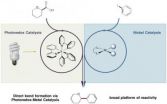(Press-News.org) In 1981, a motorcycle accident left Toronto native Kent Cochrane with severe brain damage and dramatically impaired episodic memory. Following the accident, Cochrane could no longer remember events from his past. Nor could he predict specific events that might happen in the future.
When neuroscientist Endel Tulving, PhD, asked him to describe what he would do tomorrow, Cochrane could not answer and described his state of mind as "blank."
Psychologists and neuroscientists came to know Cochrane, who passed away earlier this year, simply as "KC." Many scientists have described KC as "stuck in time," or trapped in a permanent present.
It has generally been assumed that people with episodic amnesia experience time much differently than those with more typical memory function.
However, a recent paper in Neuropsychologia co-authored by Carl F. Craver, PhD, professor of philosophy and of philosophy-neuroscience-psychology, both in Arts & Sciences at Washington University in St. Louis, disputes this type of claim.
"It's our whole way of thinking about these people that we wanted to bring under pressure," Craver said. "There are sets of claims that sound empirical, like 'These people are stuck in time.' But if you ask, 'Have you actually tested what they know about time?' the answer is no."
Time and consciousness
A series of experiments convinced Craver and his co-authors that although KC could not remember specific past experiences, he did in fact have an understanding of time and an appreciation of its significance to his life.
Interviews with KC by Craver and his colleagues revealed that KC retained much of what psychologists refer to as "temporal consciousness." KC could order significant events from his life on a timeline, and he seemed to have complete mastery of central temporal concepts.
For example, KC understood that events in the past have already happened, that they influence the future, and that once they happen, they cannot be changed.
He also knew that events in the future don't remain in the future, but eventually become present. Even more interestingly, KC's understanding of time influenced his decision-making.
If KC truly had no understanding of time, Craver argues, then he and others with his type of amnesia would act as if only the present mattered. Without understanding that present actions have future consequences or rewards, KC would have based his actions only upon immediate outcomes. However, this was not the case.
On a personality test, KC scored as low as possible on measures of hedonism, or the tendency to be a self-indulgent pleasure-seeker.
In systematic tests of his decision-making, carried out with WUSTL's Len Green, PhD, professor of psychology, and Joel Myerson, PhD, research professor of psychology, and researchers at York University in Toronto, KC also showed that he was willing to trade a smaller, sooner reward for a larger, later reward.
In other words, KC's inability to remember past events did not affect his ability to appreciate the value of future rewards.
'Questions are now wide open'
KC's case reveals how much is left to discover about memory and how it relates to human understanding of time.
"If you think about memory long enough it starts to sound magical," Craver said. "How is it that we can replay these events from our lives? And what's going on in our brains that allows us to re-experience these events from our past?"
Craver hopes that this article — the last to be published about KC during his lifetime — brings these types of questions to the forefront.
"These findings open up a whole new set of questions about people with amnesia," Craver said. "Things that we previously thought were closed questions are now wide open."
The study, "Individuals with episodic amnesia are not stuck in time," was co-authored with York University's Donna Kwan and R. Shayna Rosenbaum, PhD; and Chloe Steindam, a former undergraduate student of Craver's who graduated from WUSTL in 2013. The article appeared in Neuropsychologia on March 26, 2014.
INFORMATION:
Those with episodic amnesia are not 'stuck in time,' says philosopher Carl Craver
2014-06-24
ELSE PRESS RELEASES FROM THIS DATE:
Mining mountains of data for medical insights
2014-06-24
Epidemiologists know that an important piece of evidence is often staring you in the face – but it's not always easy to see the forest for the trees.
Danish scientists recently teamed up with University of New Mexico researchers to test a powerful new method for predicting the progress of common diseases through time by teasing out previously undetected patterns from a very large data set – in this case, the health records of Denmark's entire population.
This approach maps out surprising correlations: a disease like gout – a form of arthritis – is strongly linked to ...
Research explains action of drug that may slow aging, related disease
2014-06-24
Dietary restriction is one of the most-researched methods for slowing the aging process. Now, a new article published in The Journals of Gerontology, Series A: Biological Sciences and Medical Sciences helps explain the action of a drug that appears to mimic that method — rapamycin.
Rapamycin, an antibiotic and immunosuppressant approved for use about 15 years ago, has drawn extensive interest for its apparent ability — at least in laboratory animal tests — to emulate the ability of dietary restriction in helping animals to live both longer and healthier.
However, this ...
Hormones affect voting behavior, Nebraska researchers find
2014-06-24
OMAHA, Neb. – Researchers from the University of Nebraska at Omaha (UNO), the University of Nebraska-Lincoln (UNL) and Rice University have released a study that shows hormone levels can affect voter turnout.
As witnessed by recent voter turnout in primary elections, participation in U.S. national elections is low, relative to other western democracies. In fact, voter turnout in biennial national elections ranges includes only 40 to 60 percent of eligible voters.
The study, published June 22 in Physiology and Behavior, reports that while participation in electoral ...
A collaboration of minds and metal
2014-06-24
This past January, Derek Ahneman, a graduate student in the lab of Abigail Doyle, a Princeton University associate professor of chemistry, began work on an ambitious new project: he proposed the merger of two areas of research to enable a powerful reaction that neither could broadly achieve on its own.
One field, which is the Doyle research group's domain, was nickel catalysis, wherein nickel squeezes in and out of chemical bonds to bring molecules together. The other field was photoredox catalysis, which uses light to initiate a series of unique bond-breaking and bond-making ...
Researchers publish one of the longest longitudinal studies of cognition in MS
2014-06-24
Researchers at Kessler Foundation and the Cleveland Clinic have published one of the longest longitudinal studies of cognition in multiple sclerosis (MS). The article, "Cognitive impairment in multiple sclerosis: An 18-year follow-up study," (DOI: 10.1016/j.msard.2014.03.004) was epublished by Multiple Sclerosis and Related Disorders on April 13, 2014. Results provide insight into the natural evolution of cognitive changes over time, an important consideration for researchers and clinicians. Authors are Lauren B. Strober, PhD, of Kessler Foundation and Stephen M. Rao, ...
3-D printer for the world's largest delta?
2014-06-24
Boulder, Colo., USA - Three main rivers -- the Ganges, Brahmaputra, and Meghna -- meet in the Bengal basin to form the world's largest delta system, which serves as a gateway between the Himalayan mountains and the vast, deep-ocean Bengal Fan. This GSA BULLETIN paper by Stephen Goodbred and colleagues presents a new understanding of how this mega-delta, the Ganges-Brahmaputra-Meghna delta, came together over the past 10,000 years.
To determine the delta's construction during the Holocene, Goodbred and colleagues followed geochemical fingerprints to trace the paths and ...
NOAA GOES-R satellite black wing ready for flight
2014-06-24
The solar array that will provide power to NOAA's GOES-R satellite has been tested, approved and shipped to a facility where it will be incorporated on the spacecraft. The five sections of the solar array come together as one to resemble a giant black wing.
On May 13, 2014, the GOES-R satellite solar array panels were successful deployed in a Lockheed Martin clean room in Sunnyvale, California. The completed solar array was then delivered to Lockheed Martin's facility near Denver.
"The GOES-R solar array generates more than 4,000 watts of power, twice as much as that ...
Combo tumor imaging can distinguish malignant & benign breast tumors, help avoid biopsies
2014-06-24
PHILADELPHIA — Imaging breast tumors using four approaches together can better distinguish malignant breast tumors from those that are benign, compared with imaging using fewer approaches, and this may help avoid repeat breast biopsies, according to a study published in Clinical Cancer Research, a journal of the American Association for Cancer Research.
"By assessing many functional processes involved in cancer development, a multiparameter PET-MRI of the breast allows for a better differentiation of benign and malignant breast tumors than currently used DCE-MRI alone. ...
What millennials want
2014-06-24
Millennials, the generation after Generation X, born in the 1980s and 1990s, form their own demographic group, with their own unique tastes. According to a June 23rd panel at the 2014 Institute of Food Technologists (IFT) Annual Meeting & Food Expo® in New Orleans, industry must keep up with Millennials high-speed, digital-age expectations, if they're going to gain and keep them as customers.
"Millennials are food savvy and tech savvy," said Heidi Curry, Senior Manager Baker, Global Research and Development with Dunkin' Brands. "In addition, they're socially and environmentally ...
BMI measurement may be missing 25 percent of children who could be considered obese
2014-06-24
ROCHESTER, Minn. — Physicians using body mass index (BMI) to diagnose children as obese may be missing 25 percent of kids who have excess body fat despite a normal BMI, which can be a serious concern for long-term health, according to a Mayo Clinic study published online today in Pediatric Obesity.
The researchers found that BMI has high specificity in identifying pediatric obesity, meaning BMI accurately identifies children who are obese, but has a moderate sensitivity, meaning the BMI tool misses children who actually should be considered obese, according to the percent ...


